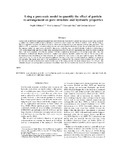Using a pore-scale model to quantify the effect of particle re-arrangement on pore structure and hydraulic properties

View/
Date
2008Author
Dikinya, O.
Lehmann, P.
Hinz, C.
Aylmore, G.
Publisher
Wiley http://www.interscience.doi.wiley.com/10.1002/hyp.6299Type
Published ArticleMetadata
Show full item recordAbstract
A pore-scale model based on measured particle size distributions has been used to quantify the changes in pore space geometry
of packed soil columns resulting from a dilution in electrolyte concentration from 500 to 1 mmol l 1 NaCl during leaching.
This was applied to examine the effects of particle release and re-deposition on pore structure and hydraulic properties. Two
different soils, an agricultural soil and a mining residue, were investigated with respect to the change in hydraulic properties.
The mining residue was much more affected by this process with the water saturated hydraulic conductivity decreasing to
0Ð4% of the initial value and the air-entry value changing from 20 to 50 cm. For agricultural soil, there was little detectable
shift in the water retention curve but the saturated hydraulic conductivity decreased to 8Ð5% of the initial value. This was
attributed to localized pore clogging (similar to a surface seal) affecting hydraulic conductivity, but not the microscopically
measured pore-size distribution or water retention. We modelled the soil structure at the pore scale to explain the different
responses of the two soils to the experimental conditions. The size of the pores was determined as a function of deposited
clay particles. The modal pore size of the agricultural soil as indicated by the constant water retention curve was 45 μm
and was not affected by the leaching process. In the case of the mining residue, the mode changed from 75 to 45 μm. This
reduction of pore size corresponds to an increase of capillary forces that is related to the measured shift of the water retention
curve.
